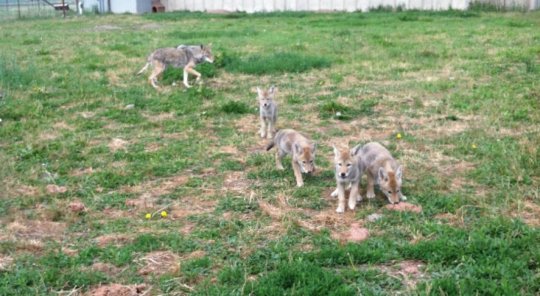[ad_1]
Across North America, coyotes are moving into urban environments, and regardless of how they feel about it, urban residents are having to get used to some new animal neighbors. A big question for wildlife researchers is how coyotes habituate to humans, which can potentially lead to conflict.
A study led by a University of Washington Tacoma faculty member, recently published in Ecology and Evolution, suggests coyotes can habituate to humans quickly and that habituated parents pass this fearlessness on to their offspring.
“Even if it’s only 0.001 percent of the time, when a coyote threatens or attacks a person or a pet, it’s national news, and wildlife management gets called in,” said first author Christopher Schell, an assistant professor at UW Tacoma. “We want to understand the mechanisms that contribute to habituation and fearlessness, to prevent these situations from occurring.”
The study, done as part of Schell’s doctoral work at the University of Chicago, focused on eight coyote families at the U.S. Department of Agriculture’s Predator Research Facility in Millville, Utah. The research center was founded in the 1970s to reduce coyote attacks on sheep and other livestock.
Until the 20th century, Schell said, coyotes lived mostly in the Great Plains. But when wolves were hunted almost to extinction in the early 1900s, coyotes lost their major predator, and their range began to expand. With continuing landscape changes, coyotes are now increasingly making their way into suburban and urban environments — including New York City, Los Angeles and cities in the Pacific Northwest — where they live, mainly off rodents and small mammals, without fear of hunters.
The new study seeks to understand how a skittish, rural coyote can sometimes transform into a bold, urban one — a shift that can exacerbate negative interactions among humans and coyotes.
“Instead of asking, ‘Does this pattern exist?’ we’re now asking, ‘How does this pattern emerge?'” Schell said.
A key factor may be parental influence. Coyotes pair for life, and both parents contribute equally to raising the offspring. This may be because of the major parental investment required to raise coyote pups, and the evolutionary pressure to guard them from larger carnivores.
The new study observed coyote families at the Utah facility during their first and second breeding seasons. These coyotes are raised in a fairly wild setting, with minimal human contact and food scattered across large enclosures.
But during the experiment researchers occasionally placed all the food near the entrance of the enclosure and had a human researcher sit just outside, watching any approaching coyotes, from five weeks to 15 weeks after the birth of the litter. Then they documented how soon the coyotes would venture toward the food.
“For the first season, there were certain individuals that were bolder than others, but on the whole they were pretty wary, and their puppies followed,” Schell said. “But when we came back and did the same experiment with the second litter, the adults would immediately eat the food — they wouldn’t even wait for us to leave the pen in some instances.
“Parents became way more fearless, and in the second litter, so, too, were the puppies.”
In fact, the most cautious pup from the second-year litter ventured out more than the boldest pup from the first-year litter.
The study also looked at two hormones in the coyotes’ fur — cortisol, the “fight or flight” hormone, and testosterone. The second litter of pups had mothers who experienced more stress during pregnancy, due to the researchers’ presence during the experiment, so that may have affected their development in the womb. But hormonal changes do not seem to have been passed down in that way.
Instead, the fur samples showed that the bolder pups had higher cortisol levels in their blood, meaning they ventured to the food despite their fear of humans. Further work would confirm whether, as Schell suspects, the cortisol levels would decline over time as the coyotes began to discount the human threat.
“The discovery that this habituation happens in only two to three years has been corroborated, anecdotally, by evidence from wild sites across the nation,” Schell said. “We found that parental effect plays a major role.”
Since arriving at UW Tacoma, Schell has begun working with Point Defiance Zoo & Aquarium to launch the Grit City Carnivore Project, which will use infrared motion-capture cameras to track coyotes and raccoons throughout the region. It’s part of the Chicago-based Urban Wildlife Information Network, studying urban wildlife across the country.
Other co-authors of the recent paper include Julie Young at the U.S. Department of Agriculture’s Predator Research Facility in Utah; Elizabeth Lonsdorf at Franklin and Marshall College in Pennsylvania; Rachel Santymire, who has a joint appointment at the University of Chicago and Chicago’s Lincoln Park Zoo, and Jill Mateo, the latter two serving as Schell’s doctoral co-advisors at the University of Chicago. The study was supported by the University of Chicago, the National Science Foundation and the U.S. Department of Agriculture.
[ad_2]















